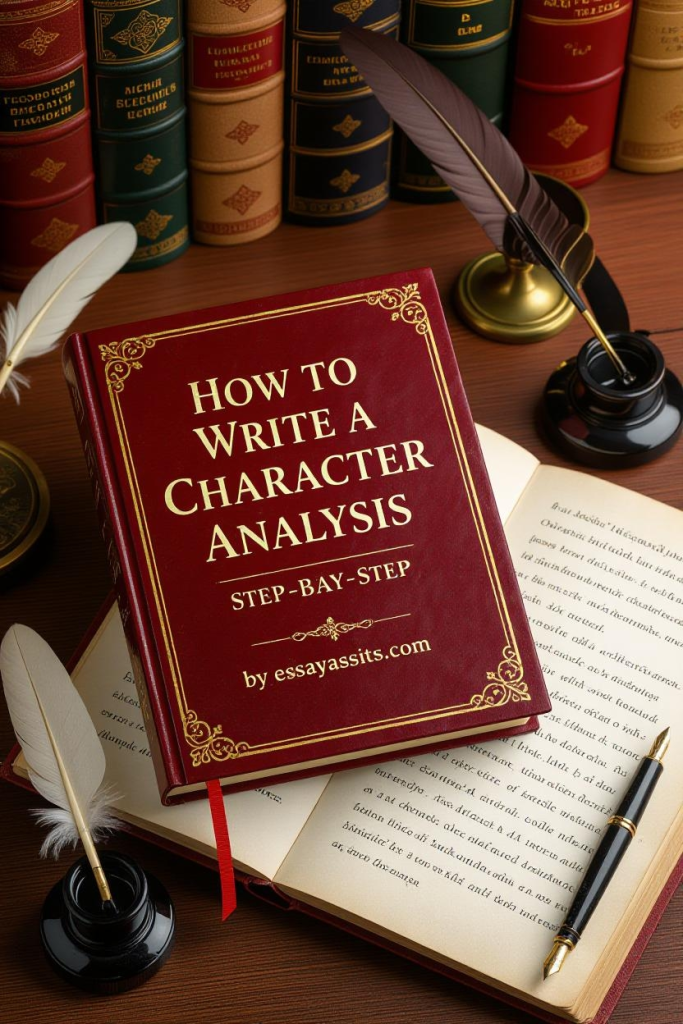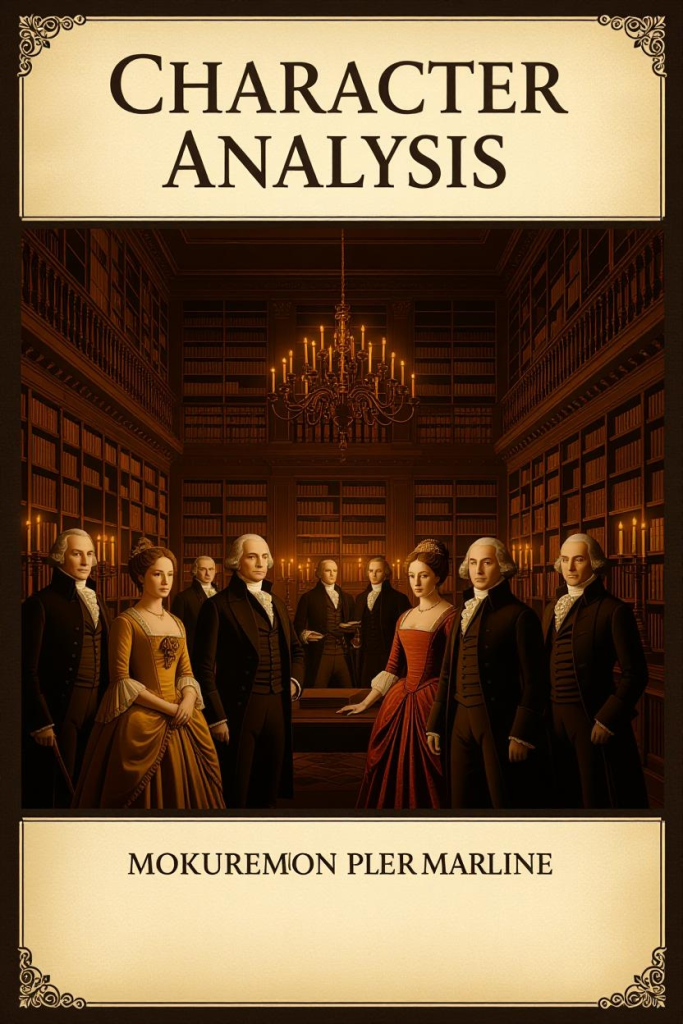
- How to Write a Character Analysis: Step-by-Step
- Step 1 — Read Closely and Take Smart Notes
- Step 2 — Decide the Focus (Make a Claim)
- Step 3 — Organize your evidence and build paragraphs
- Step 4 — Include Development and Relationships
- Step 5 — Tie Traits to Theme
- Step 6 — Craft a Strong Opening and Conclusion
- Short Example (using Jay Gatsby)
- Quick 5-Paragraph Outline (Template)
- Common Mistakes to Avoid
- Writing Tips & Finishing Checklist
Introduction
Understanding a character’s motives, personality, and development is a key part of literary analysis. A character analysis allows readers to dive deeper into what makes a fictional person believable, relatable, or symbolic. Whether you’re analyzing Shakespeare’s tragic heroes or modern-day protagonists, this guide will walk you through examples, structure, and tips to help you write an impressive character analysis essay.
What Is a Character Analysis?
A character analysis is a detailed essay that examines the personality, behavior, motivations, and role of a character within a story. It goes beyond mere description and focuses on understanding how the author develops that character and how their actions, traits, and decisions contribute to the overall theme or message of the literary work. Through character analysis, readers uncover deeper insights into human nature and the moral or emotional complexities embedded in the narrative.
When writing a character analysis, the main goal is to explore what drives the character and how they evolve throughout the story. One essential question to ask is: What does this character want? Every character has desires or goals—whether it’s love, power, justice, or freedom—that shape their behavior and decisions. These motivations often create internal or external conflicts that move the plot forward.
Another important aspect to consider is how the character changes throughout the story. Dynamic characters grow and transform based on their experiences, while static characters remain largely the same. Observing these changes helps the reader understand the lessons the character learns—or fails to learn—by the end of the story.
It’s also crucial to examine how the character’s choices affect others. A character’s decisions can inspire, harm, or transform the people around them, revealing their true nature and moral values. These interactions often highlight broader themes such as love, betrayal, or redemption.
Lastly, a thorough analysis explores the values or flaws that define the character. Strengths such as courage or integrity can make a character admirable, while flaws like pride, jealousy, or greed can lead to their downfall. Understanding this balance between virtues and weaknesses allows readers to connect with the character on a deeper, more human level.
In essence, a character analysis is not just about describing a fictional figure—it is about interpreting their purpose, growth, and significance in the story. By examining their desires, transformations, decisions, and defining traits, we gain a richer understanding of both the character and the themes the author seeks to convey.
How to Write a Character Analysis: Step-by-Step

A character analysis breaks down a fictional person so you can explain who they are, why they act the way they do, and how they contribute to the story’s meaning. This blog gives you a clear, repeatable method you can use for any novel, play, or film — plus a short sample, a ready-to-use outline, and a checklist to finish strong.
Step 1 — Read Closely and Take Smart Notes
Don’t skim. As you read, watch for: what the character says and does, how other characters respond to them, important physical or emotional details, and any repeated symbols tied to them (objects, colors, places). Jot down page numbers or scene times for evidence you’ll quote.
Quick note-taking format:
- Action → effect on plot / other characters
- Dialogue → reveals values / motives
- Key moment → change or decision
- Symbols → what they represent
Step 2 — Decide the Focus (Make a Claim)
A character analysis is an argument, not a summary. Turn your observation into a claim (thesis). Instead of “Hamlet is sad,” write a focused, debatable thesis:
Example thesis: “Hamlet’s philosophical self-questioning and moral rigidity turn his intelligence into paralysis, making him a tragic example of how thought can become action’s enemy.”
Your claim should answer one of these core questions:
- What does this character want?
- How do they change?
- What flaw or strength defines them?
- What role do they play in the author’s themes?
Step 3 — Organize your evidence and build paragraphs
Structure your essay around claims that support the thesis. For each paragraph:
- Topic sentence that states a single idea (how the character acts, changes, or what they reveal).
- Two–three pieces of textual evidence (short quotes or precise events) with page/act references.
- Analysis: explain how the evidence supports the paragraph’s point and connects back to your thesis.
- A brief transition to the next idea.
Keep each paragraph focused—don’t cram multiple big ideas into one paragraph.
Step 4 — Include Development and Relationships
Two essential angles to analyze:
- Development: Is the character static or dynamic? If they change, what causes it and what’s the result?
- Relationships: How do other characters push them, mirror them, or expose hidden traits? Relationships often reveal motives and weaknesses.
Use contrast (foils) to show the character more clearly: a foil’s opposite traits highlight your subject’s defining features.
Step 5 — Tie Traits to Theme
Always link traits or actions to the story’s larger themes. If Gatsby is “romantic and delusional,” explain how those traits comment on the American Dream. Don’t treat traits as isolated: show their significance.
Step 6 — Craft a Strong Opening and Conclusion
Opening (Intro): start with a hook (brief, insightful statement about the work or the character), introduce the work and character, and end the intro with your thesis.
Conclusion: restate the thesis in fresh language, summarize key evidence, and close with a sentence about the character’s larger significance (what the reader learns about human nature, society, or the author’s purpose)
Short Example (using Jay Gatsby)
Thesis: In The Great Gatsby, Jay Gatsby’s relentless pursuit of the past reveals the novel’s critique of the American Dream: his optimism is grand but grounded in illusion.
Paragraph idea: show Gatsby’s fixation on Daisy and the green light, quote a short line or describe a scene, analyze how his desire drives decisions that isolate him and lead to tragedy — connect to the novel’s theme that wealth cannot restore what time has taken.
Quick 5-Paragraph Outline (Template)
- Intro — hook, title/author, brief context, thesis.
- Body 1 — key trait/goal + evidence + analysis.
- Body 2 — relationships/foil + evidence + analysis.
- Body 3 — development/change and consequence + evidence + analysis.
- Conclusion — restate thesis, summarize, final reflection on theme.
Common Mistakes to Avoid
- Summarizing the plot instead of analyzing the character.
- Using vague claims without evidence.
- Overquoting long passages (use short excerpts and paraphrase).
- Ignoring the character’s relationships or the story’s context.
- Treating opinions as facts — explain why you read evidence the way you do.
Writing Tips & Finishing Checklist
- Use short quotations (under 25 words) and always explain them.
- Cite page/act/scene numbers when possible.
- Vary sentence length for rhythm; keep analysis direct (avoid purple prose).
- Proofread for clarity and to remove plot summary slips.
Checklist before handing in:
- Thesis is clear and debatable.
- Each paragraph has evidence + analysis.
- Character’s change/role/thematic significance addressed.
- Smooth transitions and a strong conclusion.
- Word count and citation format meet assignment rules.
Character Analysis Examples: Understanding Characters in Literature
Writing a character analysis can seem challenging at first — but once you learn how to explore a character’s emotions, choices, and growth, it becomes an exciting way to uncover deeper meanings in stories. In this blog, we’ll look at well-developed character analysis examples from classic and modern literature, helping you understand how to write your own with clarity and insight.This type of essay helps readers understand how authors use characters to communicate messages or themes.
For example, analyzing a character like Jay Gatsby from The Great Gatsby can reveal how ambition and illusion define the American Dream, while examining Elizabeth Bennet from Pride and Prejudice shows how intelligence and independence challenge social expectations.
Character Analysis Examples

Below are several examples to guide you through what a well-structured character analysis looks like. Each includes the character’s traits, role, and significance in the story.
1. Hamlet – Hamlet by William Shakespeare
Character Overview:
Prince Hamlet is one of literature’s most complex figures — a man torn between thought and action, morality and revenge.
Analysis:
Hamlet’s defining trait is his intellectual depth, which often becomes his downfall. His famous soliloquy, “To be or not to be,” reflects his struggle with life, death, and justice. Shakespeare portrays Hamlet as both a philosopher and a tragic hero who overthinks every decision, leading to delay and eventual catastrophe.
Key Traits: Intelligent, moral, indecisive, melancholic
Role: Protagonist, tragic hero
Theme Connection: Explores the destructive nature of indecision and moral conflict
2. Elizabeth Bennet – Pride and Prejudice by Jane Austen
Character Overview:
Elizabeth Bennet is a sharp-minded, witty, and independent young woman who defies traditional gender roles in 19th-century England.
Analysis:
Elizabeth’s pride and quick judgment often cloud her understanding of others, especially Mr. Darcy. However, as the story unfolds, she learns humility and self-awareness. Austen uses Elizabeth’s growth to critique the limitations placed on women and the influence of social class in marriage.
Key Traits: Intelligent, prideful, independent, compassionate
Role: Protagonist, moral center
Theme Connection: Challenges societal expectations and highlights personal growth through self-reflection
3. Jay Gatsby – The Great Gatsby by F. Scott Fitzgerald
Character Overview:
Jay Gatsby is a wealthy, mysterious man who becomes a symbol of the American Dream — ambitious yet hopelessly romantic.
Analysis:
Gatsby’s life revolves around his love for Daisy Buchanan and his desire to recreate the past. His grand parties, expensive lifestyle, and false identity all serve one purpose: winning Daisy’s love. However, Fitzgerald reveals that Gatsby’s dream is built on illusion, and his downfall exposes the emptiness behind material success.
Key Traits: Ambitious, idealistic, romantic, self-deceptive
Role: Protagonist, tragic dreamer
Theme Connection: The corruption of the American Dream through obsession and materialism
4. Atticus Finch – To Kill a Mockingbird by Harper Lee
Character Overview:
Atticus Finch is a lawyer and single father who stands for integrity and moral courage in a prejudiced Southern town.
Analysis:
Atticus’s unwavering commitment to justice makes him a moral beacon in the novel. Despite facing criticism, he defends Tom Robinson, a Black man falsely accused of rape, teaching his children empathy and integrity. Through Atticus, Harper Lee portrays the importance of standing for truth even when society disagrees.
Key Traits: Honest, brave, compassionate, principled
Role: Mentor, moral compass
Theme Connection: The fight against prejudice and the importance of ethical integrity
5. Katniss Everdeen – The Hunger Games by Suzanne Collins
Character Overview:
Katniss Everdeen is a resilient young woman who becomes a reluctant hero in a dystopian society ruled by fear and control.
Analysis:
Katniss’s bravery and selflessness drive the story. Her decision to volunteer for her sister and her defiance against the Capitol turn her into a symbol of rebellion. However, her internal struggle between survival and compassion makes her human and relatable. Collins uses Katniss to explore themes of sacrifice, freedom, and the human cost of violence.
Key Traits: Brave, selfless, resourceful, compassionate
Role: Protagonist, reluctant hero
Theme Connection: The moral cost of survival and resistance against oppression
6. Macbeth – Macbeth by William Shakespeare
Character Overview:
Macbeth is a Scottish nobleman whose ambition drives him to commit murder and claim the throne — only to be consumed by guilt and paranoia.
Analysis:
At first a brave warrior, Macbeth’s encounter with the witches awakens his greed for power. His transformation from loyal soldier to ruthless tyrant shows how unchecked ambition corrupts the soul. Shakespeare uses Macbeth’s downfall to explore themes of fate, morality, and the psychological consequences of guilt.
Key Traits: Ambitious, brave, paranoid, guilty
Role: Protagonist, tragic hero
Theme Connection: The destructive power of ambition and moral decay
Tips for Writing Your Own Character Analysis

Writing a character analysis can be both exciting and insightful. It allows you to explore how an author builds personality, emotion, and transformation within a story. Whether you’re analyzing a classic figure like Hamlet or a modern hero like Katniss Everdeen, the following tips will help you craft a thoughtful and compelling character analysis essay.
1. Choose a Character with Depth
Select a character who experiences internal or external change, moral conflict, or personal growth. Dynamic characters—those who evolve throughout the story—provide more material for analysis than static ones. For example, analyzing Ebenezer Scrooge’s transformation in A Christmas Carol offers richer discussion than describing a minor background figure.
2. Understand the Character’s Role in the Story
Ask yourself: What purpose does this character serve? Are they a protagonist, antagonist, mentor, or supporting role? Understanding their function in the plot helps you see how they drive the story’s events or represent a specific theme.
3. Identify Core Traits and Motivations
Every character acts based on their desires and fears. Determine what motivates your character—whether it’s love, revenge, justice, or freedom—and how these motivations shape their actions. Also, note their key traits, both good and bad, as this balance often defines their complexity.
4. Analyze Development and Change
Pay attention to how the character evolves throughout the story. What lessons do they learn? What mistakes define them? Changes in attitude, relationships, or worldview often signal deeper thematic messages. For example, Elizabeth Bennet’s journey from pride to humility mirrors Austen’s critique of social judgment.
5. Use Textual Evidence to Support Your Ideas
A strong character analysis always includes direct evidence from the text. Quote lines of dialogue, describe critical actions, or refer to key moments that reveal personality or change. Always explain how this evidence supports your interpretation rather than letting quotes stand alone.
6. Connect the Character to the Story’s Themes
Characters often embody the moral or philosophical ideas of a story. Ask how your character reflects larger themes such as ambition, love, justice, or identity. For instance, Jay Gatsby’s obsession with the past symbolizes the illusionary nature of the American Dream.
7. Examine Relationships and Conflicts
Characters are best understood through their interactions. Consider how relationships—with friends, rivals, or society—reveal deeper truths about your character. Conflict often exposes hidden values, fears, and motivations.
8. Avoid Plot Summary
Your goal is analysis, not retelling. Don’t summarize the story—focus on why the character behaves a certain way and what that behavior reveals. Assume your reader already knows the plot.
9. Structure Your Essay Clearly
Organize your analysis with a clear structure:
- Introduction: Introduce the work, author, and character; end with your thesis.
- Body Paragraphs: Discuss key traits, motivations, relationships, and development with evidence.
- Conclusion: Summarize your insights and connect the character’s journey to the story’s larger message.
10. End with Insight
Conclude your essay by reflecting on what readers can learn from this character. Does the character’s journey reveal something universal about human nature or society? A meaningful conclusion leaves a lasting impression.
Final Thought
A strong character analysis goes beyond simple description—it reveals what makes a character human, relatable, and significant within their story. When you combine close reading with thoughtful interpretation, your essay becomes not just an analysis of a fictional figure, but an exploration of human behavior itself.
If you need expert help in crafting a professional, well-researched character analysis essay, visit Essayassists.com for customized writing guidance, editing, and academic support from experienced writers.
Would you like me to follow this with a “Character Analysis Essay Template” (a ready-to-use outline or format students can follow)? It pairs perfectly with this section.
Conclusion
A strong character analysis helps you see beyond the surface of a story — it reveals the psychology, values, and struggles that make characters feel real. Whether you’re examining Shakespeare’s tragic heroes or modern dystopian figures like Katniss Everdeen, each character reflects universal human experiences.
If you need expert help crafting a powerful character analysis essay, Essayassists.com provides professional writing support to help you create polished, insightful, and original papers that impress your instructors.
A strong character analysis convinces the reader that your interpretation is the most illuminating way to read the character. Start with a precise claim, back it with tight evidence, and always show how the character’s traits and choices illuminate the story’s deeper meaning.
Want a ready-made example written fully as a student essay for a character of your choice (e.g., Hamlet, Elizabeth Bennet, Katniss Everdeen)? Tell me which character and I’ll write the full essay using this step-by-step method. A great character analysis reveals how characters reflect human nature, society, and universal struggles. Whether you’re studying classic literature or modern fiction, analyzing characters helps you understand the deeper messages behind a story.
If you need help writing your character analysis essay, Essayassists.com offers professional writing guidance and editing support to help you create a polished and insightful paper.
FAQs

1. How long should a character analysis essay be?
Most are between 500–1,000 words, depending on your assignment requirements.
2. Can I analyze more than one character?
Yes, comparing two characters can reveal contrasts and deepen your analysis.
3. What kind of evidence should I use?
Use direct quotes, dialogue, and actions that reveal the character’s motivations or transformation.
4. What’s the difference between a character analysis and a summary?
A summary retells the story, while a character analysis interprets the character’s role, motives, and meaning.
5. Where can I get help with my character analysis essay?
You can get writing guidance, editing, and personalized examples from expert writers at Essayassists.com.
7. What makes a good character analysis?
A good analysis combines personality traits, motivations, and textual evidence to explain how the character contributes to the story’s theme.
8. Should I analyze minor characters?
Yes, if they serve an important role—such as influencing the protagonist or representing a theme.
9. Can I compare two characters in one essay?
Absolutely. Comparing characters (like Macbeth vs. Banquo) can highlight key differences in values or decisions.
10. How long should a character analysis essay be?
Typically 500–1,000 words, depending on your assignment guidelines.
11. Where can I get help with my character analysis?
You can get personalized writing assistance, examples, and expert feedback at Essayassists.com.
